fuel FIAT DOBLO COMBI 2012 Owner handbook (in English)
[x] Cancel search | Manufacturer: FIAT, Model Year: 2012, Model line: DOBLO COMBI, Model: FIAT DOBLO COMBI 2012Pages: 283, PDF Size: 6.31 MB
Page 143 of 283
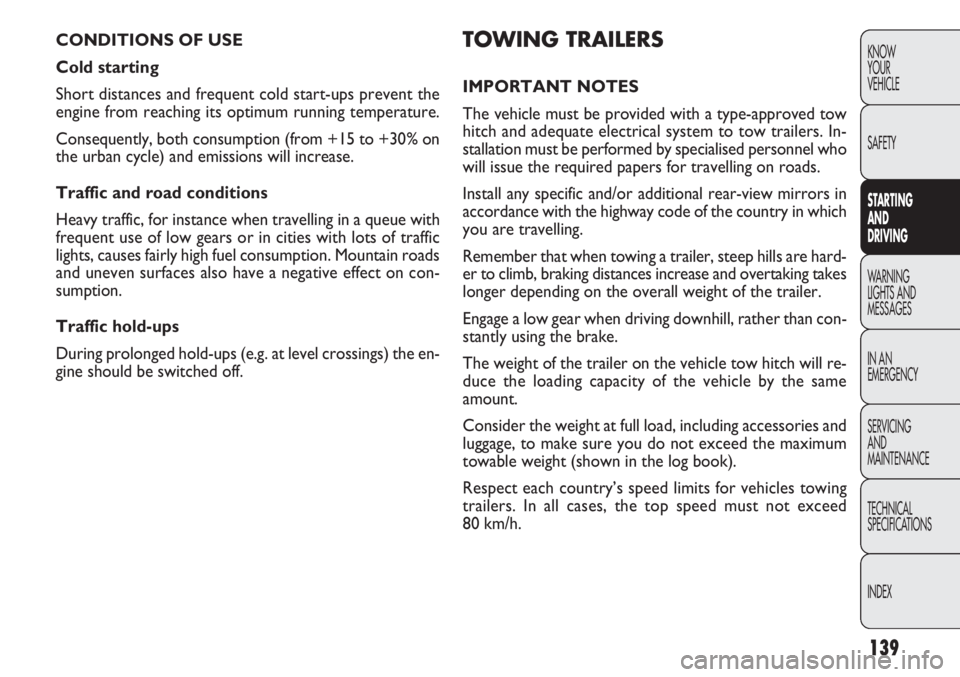
139
KNOW
YOUR
VEHICLE
SAFETY
STARTING
AN
D
DRIVING
WARNING
LIGHTS AND
MESSAGES
IN AN
EMERGENCY
SERVICING
AND
MAINTENANCE
TECHNICAL
SPECIFICA TIONS
INDEX
TOWING TRAILERS
IMPORTANT NOTES
The vehicle must be provided with a type-approved tow
hitch and adequate electrical system to tow trailers. In-
stallation must be performed by specialised personnel who
will issue the required papers for travelling on roads.
Install any specific and/or additional rear-view mirrors in
accordance with the highway code of the country in which
you are travelling.
Remember that when towing a trailer, steep hills are hard-
er to climb, braking distances increase and overtaking takes
longer depending on the overall weight of the trailer.
Engage a low gear when driving downhill, rather than con-
stantly using the brake.
The weight of the trailer on the vehicle tow hitch will re-
duce the loading capacity of the vehicle by the same
amount.
Consider the weight at full load, including accessories and
luggage, to make sure you do not exceed the maximum
towable weight (shown in the log book).
Respect each country’s speed limits for vehicles towing
trailers. In all cases, the top speed must not exceed
80 km/h.
CONDITIONS OF USE
Cold starting
Short distances and frequent cold start-ups prevent the
engine from reaching its optimum running temperature.
Consequently, both consumption (from +15 to +30% on
the urban cycle) and emissions will increase.
Traffic and road conditions
Heavy traffic, for instance when travelling in a queue with
frequent use of low gears or in cities with lots of traffic
lights, causes fairly high fuel consumption. Mountain roads
and uneven surfaces also have a negative effect on con-
sumption.
Traffic hold-ups
During prolonged hold-ups (e.g. at level crossings) the en-
gine should be switched off.
Page 153 of 283

149
KNOW
YOUR
VEHICLE
SAFETY
STARTING
AND
DRIVING
WA R N I NG
LIGHTS AND
MESSAGES
IN AN
EMERGENCY
SERVICING
AND
MAINTENANCE
TECHNICAL
SPECIFICA TIONS
INDEXA specific message is displayed on certain versions.
Under these conditions, the vehicle can continue trav-
elling at moderate speed without demanding excessive
effort from the engine. Prolonged use of the vehicle
with the warning light on may cause damage. Go to a
Fiat Dealership as soon as possible.
The warning light goes out after the fault disappears,
but the notification is stored in the system.
❒ flashing: this indicates possible damage to the catalytic
converter (see “EOBD system” in the “Dashboard and
controls” section).
If the light flashes, come off the accelerator pedal to re-
duce engine revs until the warning light stops flashing;
continue the journey at moderate speed, trying to avoid
driving conditions that may cause further flashing, and
get to a Fiat Dealership as soon as possible.
INJECTION SYSTEM FAILURE
(Multijet versions – amber)
EOBD ENGINE MANAGEMENT
SYSTEM FAILURE
(petrol versions – amber)
Injection system failure
Under normal conditions, turning the ignition key to MAR,
the warning light turns on but it should go off after the en-
gine starts. If the warning light stays on or comes on when
travelling, it means there is a fault in the injection system
which could cause loss of performance, poor handling and
high fuel consumption levels.
A specific message is displayed on certain versions.
Under these conditions, the vehicle can continue travel-
ling at moderate speed without demanding excessive ef-
fort from the engine. In any case, you should go to a Fiat
Dealership as soon as possible.
EOBD engine management system failure
Under normal conditions, turning the ignition key to MAR,
the warning light turns on but it should go off after the en-
gine starts.
This indicates that the warning light is working correctly.
If the warning light either stays on or comes on during
your journey:
❒ on permanently: this means there is a fault in the sup-
ply/ignition system which could cause high exhaust
emissions, loss of performance, poor handling and high
fuel consumption levels.
U
Go to a Fiat Dealership as soon as possi-
ble if warning light
Udoes not light up
when the key is turned to MAR or if, while
travelling, the warning light comes on either per-
manently or flashing (along with a message on the
display on certain versions). The operation of the
Uwarning light may be checked by traffic police
using appropriate equipment. Respect the regula-
tions in force in the country where you are driving.
Page 154 of 283
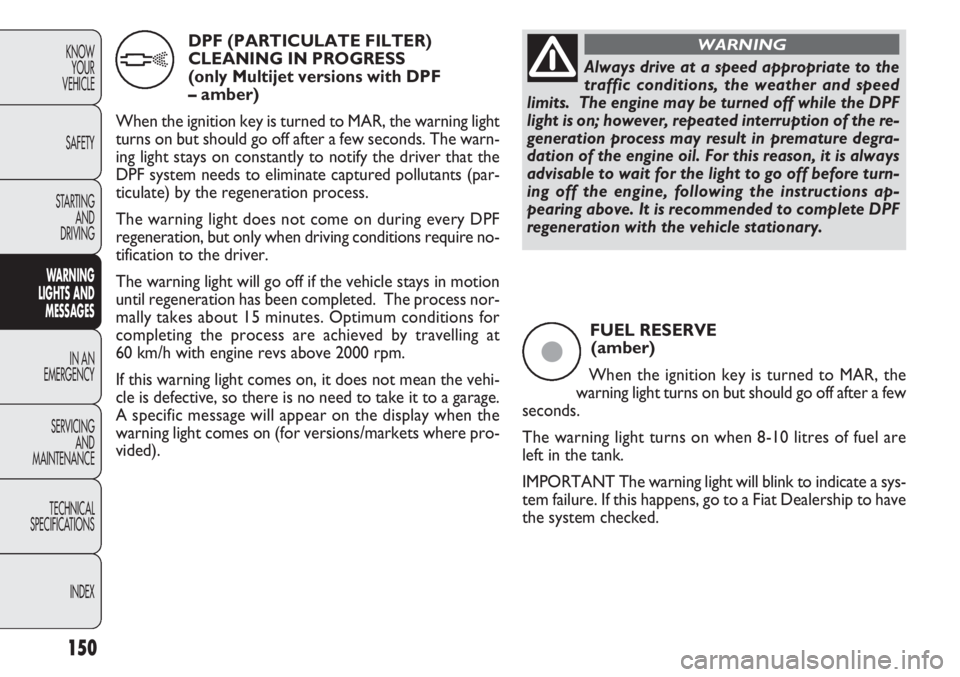
150
KNOWYOUR
VEHICLE
SAFETY
STARTING AND
DRIVING
WARNING
LIGHTS AND MESSAGES
IN AN
EMERGENCY
SERVICING AND
MAINTENANCE
TECHNICAL
SPECIFICA TIONS
INDEX
FUEL RESERVE (amber)
When the ignition key is turned to MAR, the
warning light turns on but should go off after a few
seconds.
The warning light turns on when 8-10 litres of fuel are
left in the tank.
IMPORTANT The warning light will blink to indicate a sys-
tem failure. If this happens, go to a Fiat Dealership to have
the system checked.
DPF (PARTICULATE FILTER)
CLEANING IN PROGRESS
(only Multijet versions with DPF
– amber)
When the ignition key is turned to MAR, the warning light
turns on but should go off after a few seconds. The warn-
ing light stays on constantly to notify the driver that the
DPF system needs to eliminate captured pollutants (par-
ticulate) by the regeneration process.
The warning light does not come on during every DPF
regeneration, but only when driving conditions require no-
tification to the driver.
The warning light will go off if the vehicle stays in motion
until regeneration has been completed. The process nor-
mally takes about 15 minutes. Optimum conditions for
completing the process are achieved by travelling at
60 km/h with engine revs above 2000 rpm.
If this warning light comes on, it does not mean the vehi-
cle is defective, so there is no need to take it to a garage.
A specific message will appear on the display when the
warning light comes on (for versions/markets where pro-
vided).
h
ç
Always drive at a speed appropriate to the
traffic conditions, the weather and speed
limits. The engine may be turned off while the DPF
light is on; however, repeated interruption of the re-
generation process may result in premature degra-
dation of the engine oil. For this reason, it is always
advisable to wait for the light to go off before turn-
ing off the engine, following the instructions ap-
pearing above. It is recommended to complete DPF
regeneration with the vehicle stationary.
WARNING
Page 155 of 283
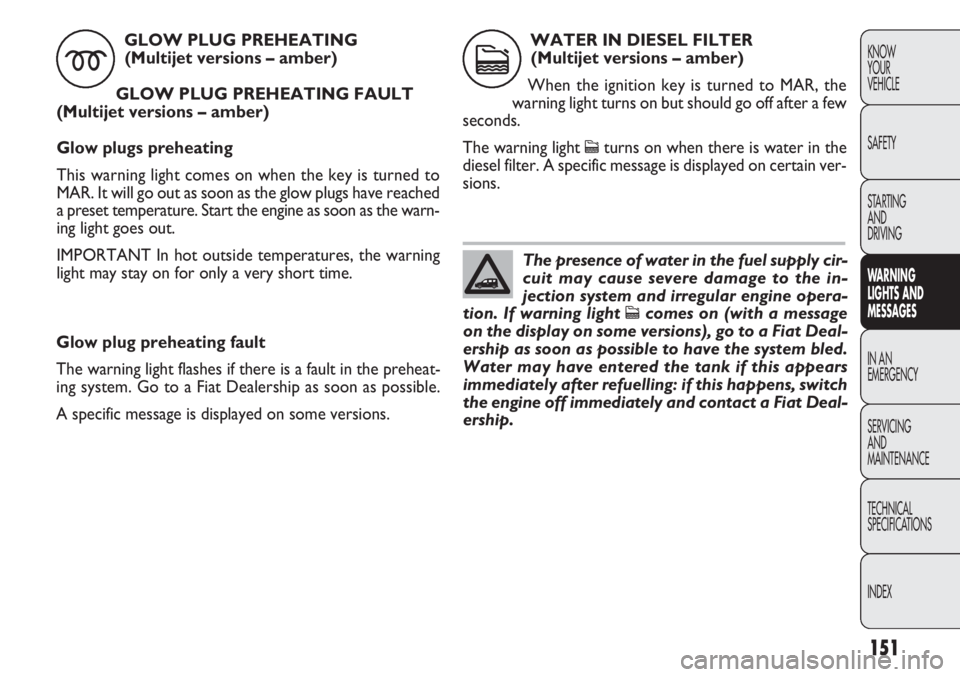
151
KNOW
YOUR
VEHICLE
SAFETY
STARTING
AND
DRIVING
WA R N I NG
LIGHTS AND
MESSAGES
IN AN
EMERGENCY
SERVICING
AND
MAINTENANCE
TECHNICAL
SPECIFICA TIONS
INDEX
Glow plug preheating fault
The warning light flashes if there is a fault in the preheat-
ing system. Go to a Fiat Dealership as soon as possible.
A specific message is displayed on some versions. GLOW PLUG PREHEATING
(Multijet versions – amber)
GLOW PLUG PREHEATING FAULT
(Multijet versions – amber)
Glow plugs preheating
This warning light comes on when the key is turned to
MAR. It will go out as soon as the glow plugs have reached
a preset temperature. Start the engine as soon as the warn-
ing light goes out.
IMPORTANT In hot outside temperatures, the warning
light may stay on for only a very short time.
m
WATER IN DIESEL FILTER (Multijet versions – amber)
When the ignition key is turned to MAR, the
warning light turns on but should go off after a few
seconds.
The warning light
cturns on when there is water in the
diesel filter. A specific message is displayed on certain ver-
sions.
c
The presence of water in the fuel supply cir-
cuit may cause severe damage to the in-
jection system and irregular engine opera-
tion. If warning light
ccomes on (with a message
on the display on some versions), go to a Fiat Deal-
ership as soon as possible to have the system bled.
Water may have entered the tank if this appears
immediately after refuelling: if this happens, switch
the engine off immediately and contact a Fiat Deal-
ership.
Page 156 of 283
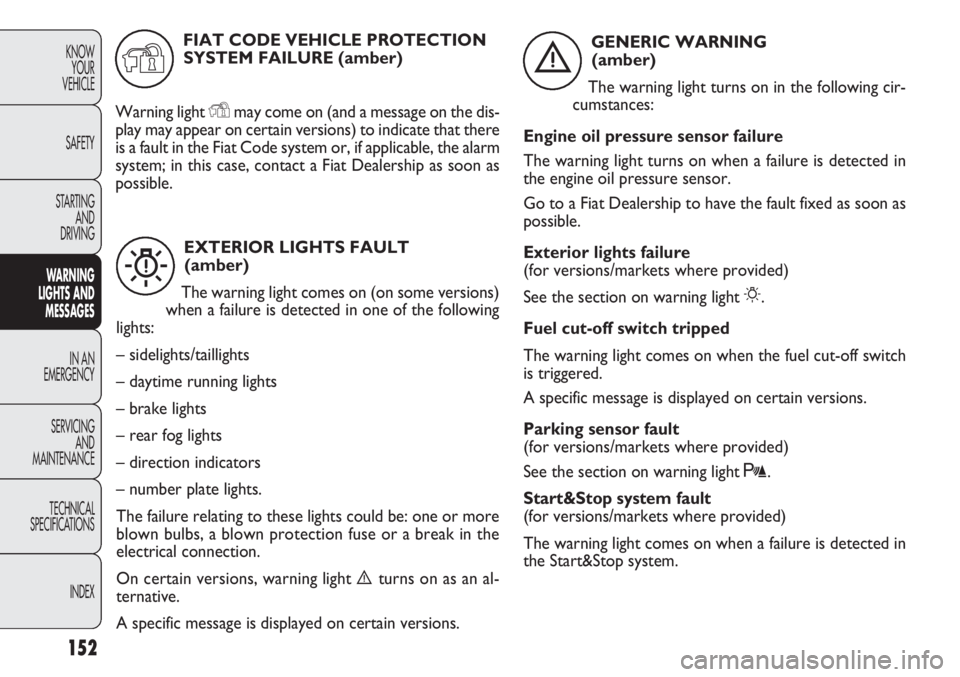
152
KNOWYOUR
VEHICLE
SAFETY
STARTING AND
DRIVING
WARNING
LIGHTS AND MESSAGES
IN AN
EMERGENCY
SERVICING AND
MAINTENANCE
TECHNICAL
SPECIFICA TIONS
INDEX
EXTERIOR LIGHTS FAULT(amber)
The warning light comes on (on some versions)
when a failure is detected in one of the following
lights:
– sidelights/taillights
– daytime running lights
– brake lights
– rear fog lights
– direction indicators
– number plate lights.
The failure relating to these lights could be: one or more
blown bulbs, a blown protection fuse or a break in the
electrical connection.
On certain versions, warning light è turns on as an al-
ternative.
A specific message is displayed on certain versions.
W
GENERIC WARNING (amber)
The warning light turns on in the following cir-
cumstances:
Engine oil pressure sensor failure
The warning light turns on when a failure is detected in
the engine oil pressure sensor.
Go to a Fiat Dealership to have the fault fixed as soon as
possible.
Exterior lights failure
(for versions/markets where provided)
See the section on warning light
6.
Fuel cut-off switch tripped
The warning light comes on when the fuel cut-off switch
is triggered.
A specific message is displayed on certain versions.
Parking sensor fault
(for versions/markets where provided)
See the section on warning light t.
Start&Stop system fault
(for versions/markets where provided)
The warning light comes on when a failure is detected in
the Start&Stop system.
è
FIAT CODE VEHICLE PROTECTION SYSTEM FAILURE (amber)
Warning light
Ymay come on (and a message on the dis-
play may appear on certain versions) to indicate that there
is a fault in the Fiat Code system or, if applicable, the alarm
system; in this case, contact a Fiat Dealership as soon as
possible.
Y
Page 160 of 283
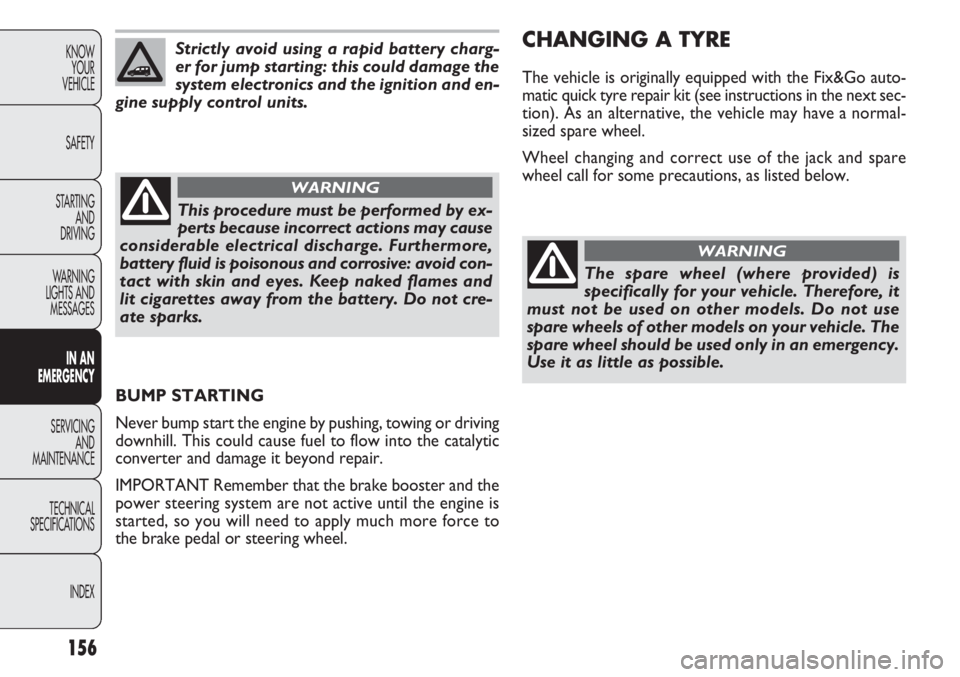
156
KNOWYOUR
VEHICLE
SAFETY
STARTING AND
DRIVING
WARNING
LIGHTS AND MESSAGES
IN AN
EMERGENCY
SERVICING AND
MAINTENANCE
TECHNICAL
SPECIFICA TIONS
INDEXStrictly avoid using a rapid battery charg-
er for jump starting: this could damage the
system electronics and the ignition and en-
gine supply control units.
This procedure must be performed by ex-
perts because incorrect actions may cause
considerable electrical discharge. Furthermore,
battery fluid is poisonous and corrosive: avoid con-
tact with skin and eyes. Keep naked flames and
lit cigarettes away from the battery. Do not cre-
ate sparks.
WARNING
BUMP STARTING
Never bump start the engine by pushing, towing or driving
downhill. This could cause fuel to flow into the catalytic
converter and damage it beyond repair.
IMPORTANT Remember that the brake booster and the
power steering system are not active until the engine is
started, so you will need to apply much more force to
the brake pedal or steering wheel.
CHANGING A TYRE
The vehicle is originally equipped with the Fix&Go auto-
matic quick tyre repair kit (see instructions in the next sec-
tion). As an alternative, the vehicle may have a normal-
sized spare wheel.
Wheel changing and correct use of the jack and spare
wheel call for some precautions, as listed below.
The spare wheel (where provided) is
specifically for your vehicle. Therefore, it
must not be used on other models. Do not use
spare wheels of other models on your vehicle. The
spare wheel should be used only in an emergency.
Use it as little as possible.
WARNING
Page 187 of 283
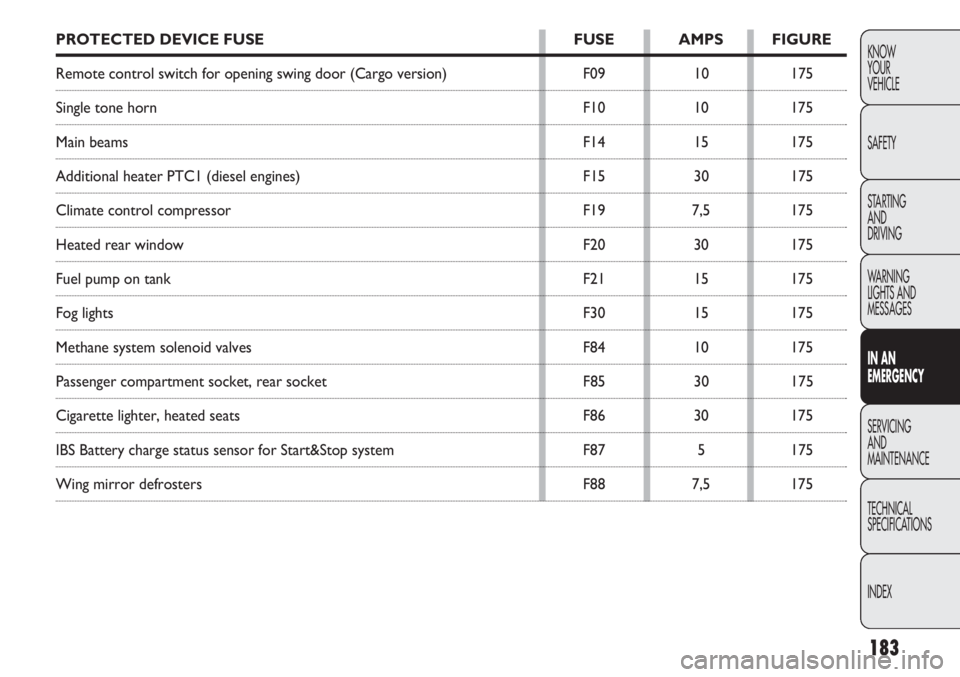
183
KNOW
YOUR
VEHICLE
SAFETY
STARTING
AND
DRIVING
WARNING
LIGHTS AND
MESSAGES
IN AN
EMERGENCY
SERVICING
AND
MAINTENANCE
TECHNICAL
SPECIFICATIONS
INDEXPROTECTED DEVICE FUSE FUSE AMPS FIGURE
Remote control switch for opening swing door (Cargo version) F0910175
Single tone horn F1010175
Main beams F1415175
Additional heater PTC1 (diesel engines) F1530175
Climate control compressor F197,5175
Heated rear window F2030175
Fuel pump on tank F2115175
Fog lights F3015175
Methane system solenoid valves F8410175
Passenger compartment socket, rear socket F8530175
Cigarette lighter, heated seats F8630175
IBS Battery charge status sensor for Start&Stop system F875175
Wing mirror defrosters F887,5175
Page 196 of 283
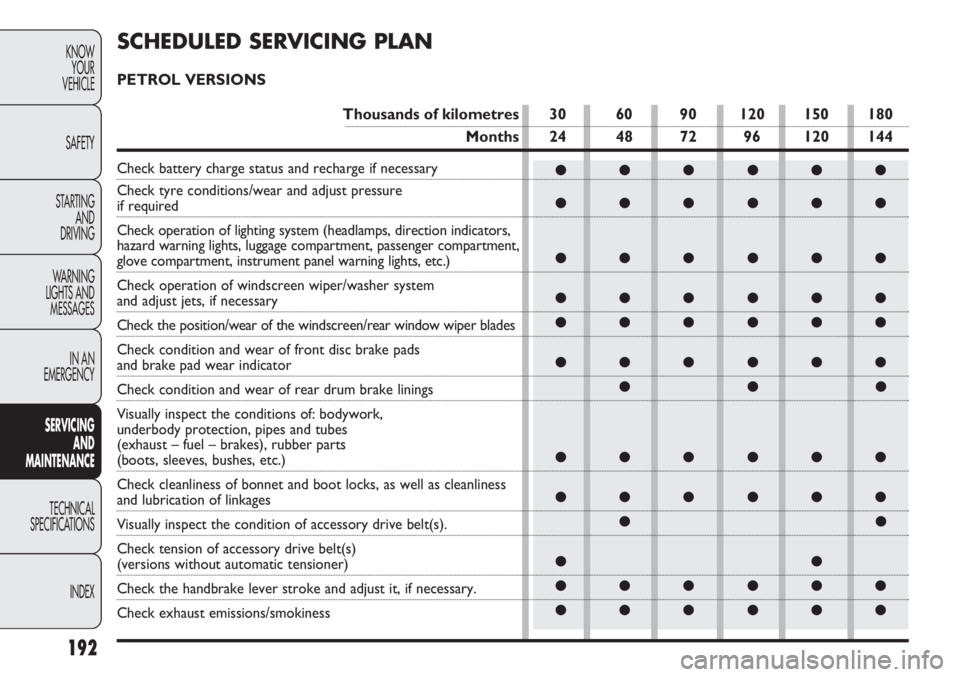
192
KNOWYOUR
VEHICLE
SAFETY
STARTING AND
DRIVING
WARNING
LIGHTS AND MESSAGES
IN AN
EMERGENCY
SERV IC
ING
AND
MAINTENANCE
TECHNICAL
SPECIFICA TIONS
INDEX
●●●●●●
●●●●●●
●●●●●●
●●●●●●
●●●●●●
●●●●●● ●●●
●●●●●●
●●●●●● ●●
●●
●●●●●●
●●●●●●
SCHEDULED SERVI CING PLAN
PETROL VERSIONS
Thousands of kilometres 30 60 90 120 150 180
Months 24 48 72 96 120 144
Check battery charge status and recharge if necessary
Check tyre conditions/wear and adjust pressure
if required
Check operation of lighting system (headlamps, direction indicators,
hazard warning lights, luggage compartment, passenger compartment,
glove compartment, instrument panel warning lights, etc.)
Check operation of windscreen wiper/washer system
and adjust jets, if necessary
Check the position/wear of the windscreen/rear window wiper blades
Check condition and wear of front disc brake pads
and brake pad wear indicator
Check condition and wear of rear drum brake linings
Visually inspect the conditions of: bodywork,
underbody protection, pipes and tubes
(exhaust – fuel – brakes), rubber parts
(boots, sleeves, bushes, etc.)
Check cleanliness of bonnet and boot locks, as well as cleanliness
and lubrication of linkages
Visually inspect the condition of accessory drive belt(s).
Check tension of accessory drive belt(s)
(versions without automatic tensioner)
Check the handbrake lever stroke and adjust it, if necessary.
Check exhaust emissions/smokiness
Page 198 of 283
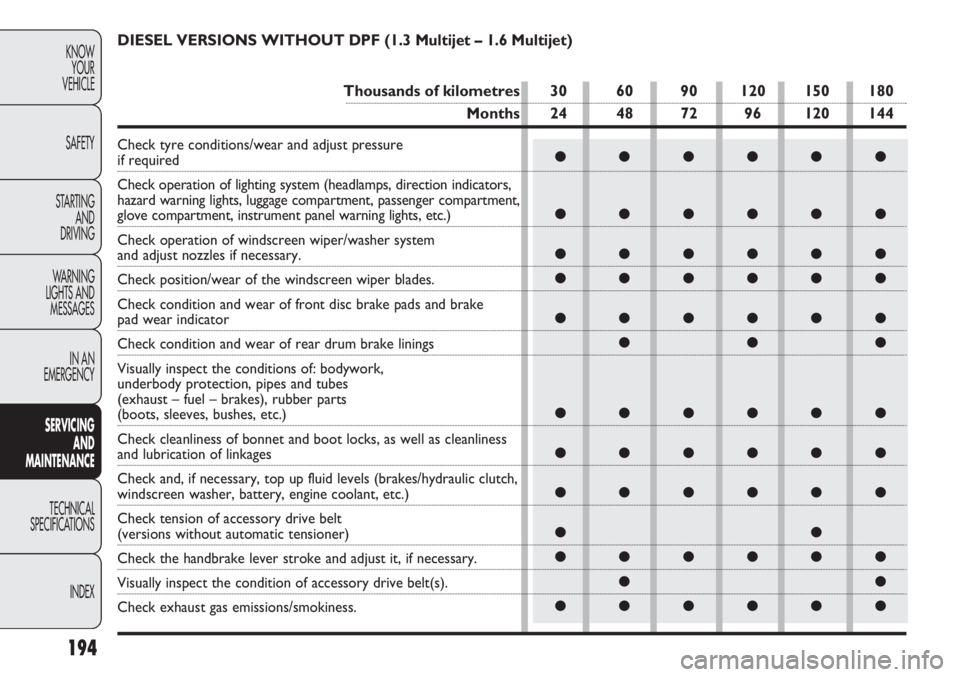
194
KNOWYOUR
VEHICLE
SAFETY
STARTING AND
DRIVING
WARNING
LIGHTS AND MESSAGES
IN AN
EMERGENCY
SERV IC
ING
AND
MAINTENANCE
TECHNICAL
SPECIFICA TIONS
INDEX
●●●●●●
●●●●●●
●●●●●●
●●●●●●
●●●●●● ●●●
●●●●●●
●●●●●●
●●●●●●
●●
●●●●●● ●●
●●●●●●
DIESEL VERSIONS WITHOUT DPF (1.3 Multijet – 1.6 Multijet)
Thousands of kilometres 30 60 90 120 150 180
Months 24 48 72 96 120 144
Check tyre conditions/wear and adjust pressure if required
Check operation of lighting system (headlamps, direction indicators,
hazard warning lights, luggage compartment, passenger compartment,
glove compartment, instrument panel warning lights, etc.)
Check operation of windscreen wiper/washer system
and adjust nozzles if necessary.
Check position/wear of the windscreen wiper blades.
Check condition and wear of front disc brake pads and brake
pad wear indicator
Check condition and wear of rear drum brake linings
Visually inspect the conditions of: bodywork,
underbody protection, pipes and tubes
(exhaust – fuel – brakes), rubber parts
(boots, sleeves, bushes, etc.)
Check cleanliness of bonnet and boot locks, as well as cleanliness
and lubrication of linkages
Check and, if necessary, top up fluid levels (brakes/hydraulic clutch, \
windscreen washer, battery, engine coolant, etc.)
Check tension of accessory drive belt
(versions without automatic tensioner)
Check the handbrake lever stroke and adjust it, if necessary.
Visually inspect the condition of accessory drive belt(s).
Check exhaust gas emissions/smokiness.
Page 199 of 283
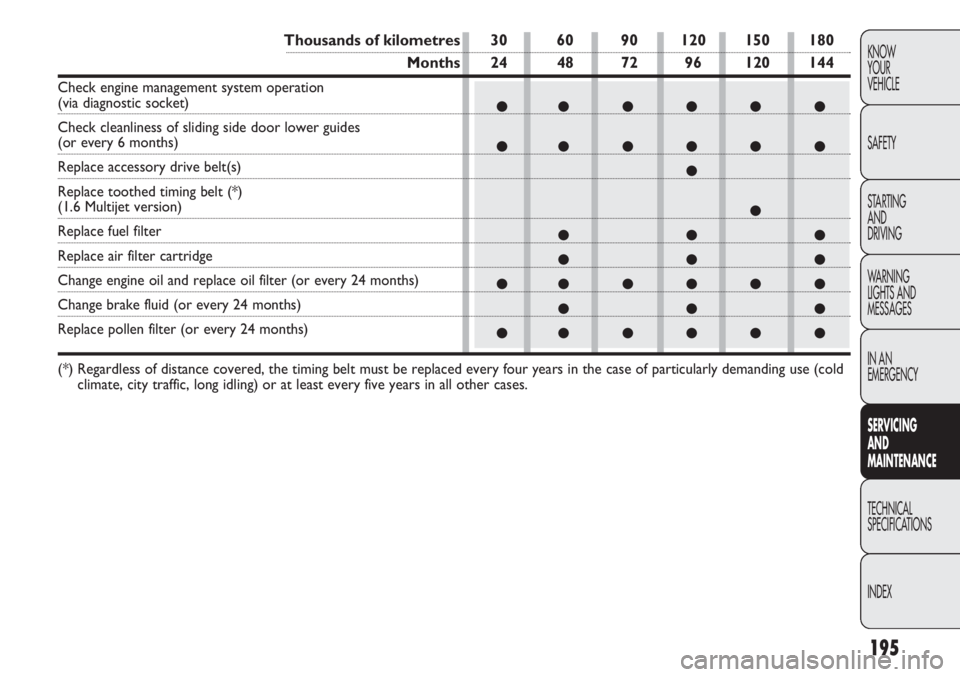
195
KNOW
YOUR
VEHICLE
SAFETY
STARTING
AND
DRIVING
WARNING
LIGHTS AND
MESSAGES
IN AN
EMERGENCY
SERVIC
ING
AND
MAINTENANCE
TECHNICAL
SPECIFICA TIONS
INDEX
●●●●●●
●●●●●● ●
●
●●●
●●●
●●●●●●
●●●
●●●●●●
Thousands of kilometres 30 60 90 120 150 180
Months 24 48 72 96 120 144
Check engine management system operation (via diagnostic socket)
Check cleanliness of sliding side door lower guides
(or every 6 months)
Replace accessory drive belt(s)
Replace toothed timing belt (*)
(1.6 Multijet version)
Replace fuel filter
Replace air filter cartridge
Change engine oil and replace oil filter (or every 24 months)
Change brake fluid (or every 24 months)
Replace pollen filter (or every 24 months)
(*) Regardless of distance covered, the timing belt must be replaced every f\
our years in the case of particularly demanding use (cold
climate, city traffic, long idling) or at least every five years in all\
other cases.